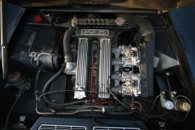A C Roney Sports Cars 07968 624949
TVR, Trevor Wilkinson, TVR Cars, TVR Power, TVR Engineering, TVR Racing Green, Racing Green TVR, Exactly TVR, Adrien Venn, Cambridge, Classic Cars, Classic TVR, Grantura, Grantura Mk3, Grantura Mk4 1800S, TVR Vixen, Vixen S2, Vixen S3, Vixen S4, TVR Griffith, Griffith 200, Griffith 400, TVR V8, V8, Griffith V8, Taimar Turbo, Taimar Turbo SE, TVR M3000, TVR M2500, TVR M1600, TVR Tuscan, Tuscan V6, V6, Tuscan V8, Tuscan Speed 6, AJP V8, AJP 4.5, Race Preparation, Amos Roney, A Roney, Amos, A Moose, Mooseee, Peter Wheeler,
A C Roney Sports Cars © 2009

Exterior Features

Interior Features

Mechanical Features
Date Registered December 1973
Registration SAC 360M
Chassis 94 of 120
Engine
Mileage 69,900
Exterior Colour Black & Gold fleck
Interior Colour Oatmeal
Electric windows
Battery condition indicator
Map lamp
Clock
Outside temperature gauge
Auxiliary lamps
Steering column safety (telescope on impact)
Brake fail warning lamp
Lotus-Ford Twin Cam
Engine Output 126 b.h.p.
Top Speed over 120 m.p.h.
0 - 60 m.p.h. in 7.9 secs
5 Speed Manual
Stainless steel manifold & exhaust
Every effort has been made to check the accuracy of the information contained in this web site, some errors in compiling the information may have occurred and we cannot accept liability for loss or damage arising from misleading information. You are therefore strongly advised not to rely on the information provided in respect of vehicles, and to examine the vehicles and to check the accuracy of the information supplied before deciding to purchase a vehicle described. Your statutory rights as a consumer are not affected by this statement.
Telephone +44 (0)7968 624949
E-mail acr1@me.com
£SOLD

Lotus Elan +2S 130/5 JPS



Standard Equipment
Oil Pressure Gauge
Electric Windows
Handbrake Warning Lamp
Additional Equipment (US Federal and ‘S’ model)
5 Speed Gear Box
Battery Condition Indicator
Map Lamp
Clock
Outside (ambient) Temperature Gauge
Auxiliary Lamps (driving and fog)
Steering Column Safety (telescope on impact)
Brake Fail Warning Lamp
Exterior
Brakes Wheels and Tyres
Disc Brakes All Round
Aluminum Wheels and Dunlop SP Elite 165 SR 13 82S Tyres
Engine and Transmission
The Lotus-Ford Twin Cam is a 1558 cc engine developed for the 1962 Lotus Elan and also used in a variety of other vehicles up until mid 1970's.
required a low cost, compact, yet powerful engine for the 1962 Lotus Elan. Colin Chapman chose to use the 116E thin wall cast iron block first used by Ford in the Consul Classic, the Capri and later to be used in the Cortina. While the basic engine design was relatively sound, being of 5 main bearing construction, it was by no means a performance engine. To achieve the power required, Chapman commissioned Harry Mundy, then technical editor for Auto Car magazine, to design a double overhead camshaft conversion. This comprised an aluminium cylinder head and an aluminium front cover assembly containing the water pump and the chain driven camshaft drive.
In its initial evolution the engine had a cubic capacity of 1498 cc and produced approximately 100 bhp (75 kW). After approximately 50 engines had been produced (only 22 engines of this initial specification made their way into roadgoing Elans, the rest being used in the Lotus 23) the specification was changed so the engine had a 0.060" larger bore dimension as standard thereby increasing the cubic capacity to 1558 cc. This enabled an overbore of 0.040" permitted by the FIA regulations would still mean a cubic capacity below the new 1600 cc FIA class limit.
Technical
The 1558 cc twincam engine has internal dimensions as follows:
3.250 inches (82.55 mm) bore
2.900 inches (72.746 mm) stroke
The 116E block was used in 5 basic versions
The Mark 1 - from 1962 to 1967
The -6015 block with round main bearing caps and 4 bolt crankshaft
The Mark 2 - from 1967-1975
The 3020-6015 block with round main bearing caps and 6 bolt crankshaft
The 681F-6015 block with round main bearing caps and 6 bolt crankshaft
The 681F-6015 block with square main bearing caps and 6 bolt crankshaft
The 701F-6015 block with square main bearing caps and 6 bolt crankshaft
The cylinder head has hemispherical combustion chambers similar to that first used by Peugeot on their 1912 Grand Prix car and subsequently refined by Jaguar in their XK engine of the 1950s
Valve sizes used are 1.530" diameter inlet and 1.325" diameter exhaust on all engines except the "big valve" Elan Sprint and Lotus Europa models which have an inlet valve measuring 1.565" diameter.
Applications
-
■1962-1974 Lotus Elan
-
■1963-1970 Lotus Cortina
-
■1968-1970 Ford Escort Twin Cam
-
■1971-1975 Lotus Europa
-
■1973-1974 Lotus Seven
-
■
Motorsport
The Lotus Twin Cam is an enduring engine and even to this day is still used in rallying, hillclimbing, autocross and of course, historic motorsport events. In fact, some may argue that the "twink" is more popular in motorsport now than it was during it's production. This, in no small part, is due to the likes of companies such as QED Motorsport who strive to keep the engine in service with hard or impossible to find engine components. QED even bought the license to officially re-produce the Twin Cam’s Cylinder Head !
History
Owned by the same person for the past 30 year, in original and good condition, including the chassis which has always been waxoiled and the car always garaged (same garage, same address). History file dating back 27 years, MoT’s to verify milage.
Just had New Dellorto Carbs and the exhaust made by Lotus.
Model History
http://en.wikipedia.org/wiki/Lotus_Elan
The original Elan was introduced in 1962 as a roadster, although an optional hardtop was offered in 1963 and a coupe version in 1965. The two seat Lotus Elan replaced the elegant, but unreliable and expensive to produce Lotus Elite. It was the first Lotus road car to use the now famous steel backbone chassis with a fibreglass body. At 1,500 lb (680 kg), the Elan embodied the Colin Chapman minimum weight design philosophy. Initial versions of the Elan were also available as a kit to be assembled by the customer. The Elan was technologically advanced with a twin-cam 1558 cc engine, 4-wheel disc brakes, and 4-wheel independent suspension. The Lotus-Ford Twin Cam engine was based on Ford’s Kent, with a Lotus-inspired Cosworth alloy twin-cam head. This Lotus-Ford 4-cylinder engine would go on to be used in a number of Lotus production and racing models.
An Elan +2 was introduced in 1967 with a longer wheelbase and two more rear seats. The Elan + 2 embodied the Lotus spirit: It was a fast and agile sport coupe, with very elegant lines. It combined the performance and reliability of the Elan "Coupe" with genuine 2+2 passenger comfort. Tested maximum power: 108-126 bhp(net)depending on the model); top speed: 120 mph (190 km/h), 0-60 mph in 7.9 seconds, 0-100 mph 21.8 seconds. 5,200 Elans + 2 were made: less than 1,200 of these cars remain in the roads today. Their relative rarity, beautiful lines, impressive performance and practicality are the main factors for the rising interest on these cars among collectors.
The Elan ceased production in 1973 and the Elan +2 in 1975. An estimated total of 17,000 original Elans and Elan +2's were built. Because of its successful design and technological sophistication, the Elan went on to become Lotus' first commercial success, reviving a company stretched thin by the more exotic and less commercially successful Elite, and enabling funding of the Lotus success in racing over the next ten years.













☎ +44 (0)7968 624949 E-mail acr1@me.com A C Roney Sports Cars © 2009 website by AC Roney